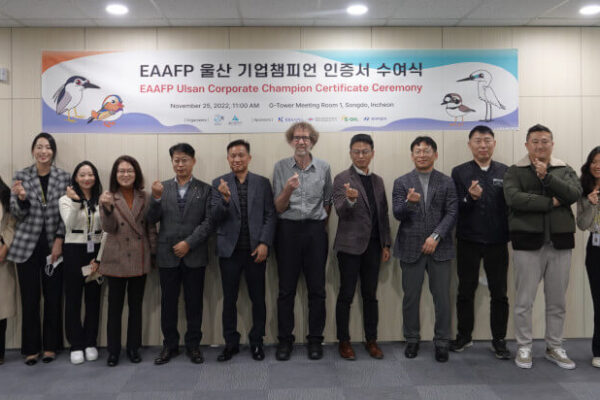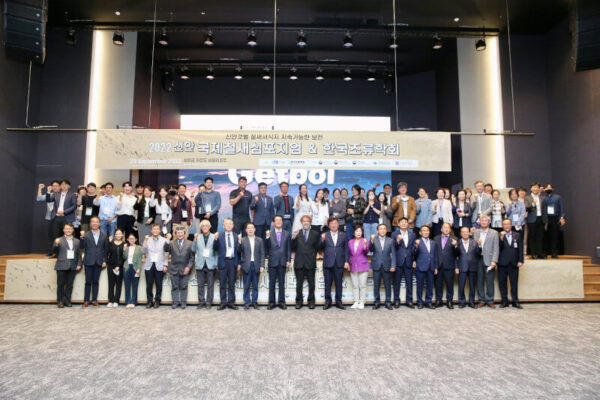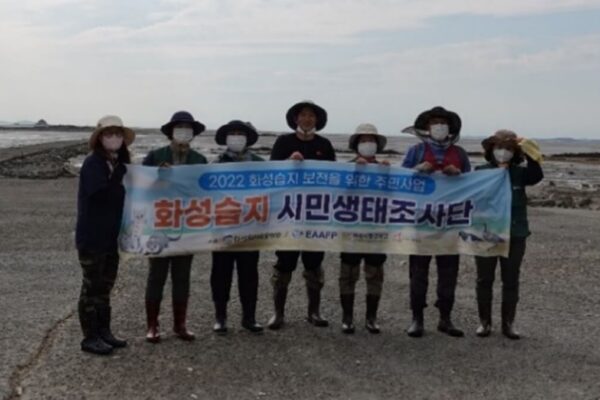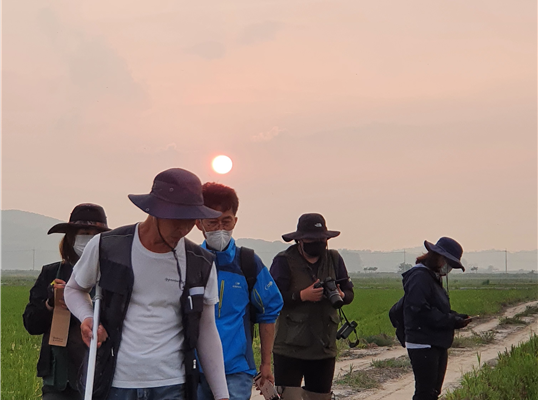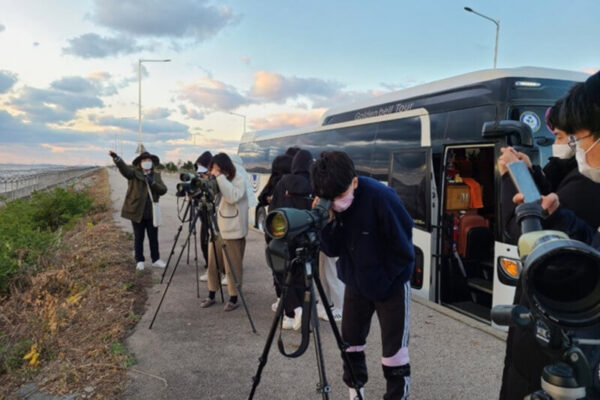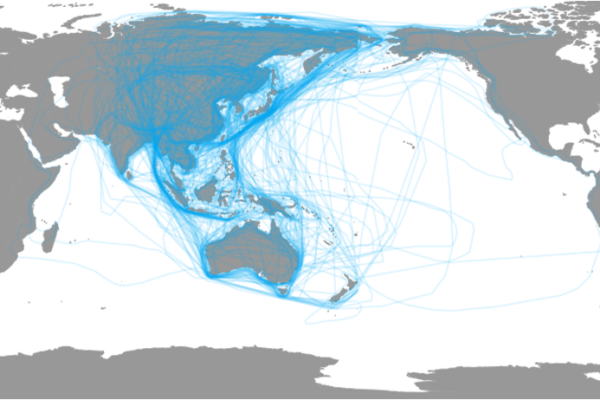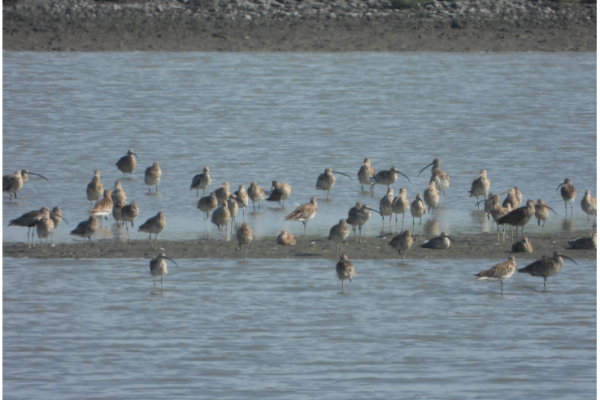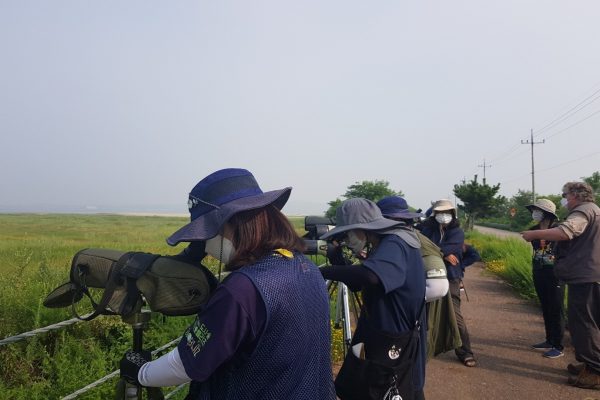-
Celebrating the first year of the EAAFP Corporate Champion programme – Ulsan Corporate Champion Certificate-presentation Ceremony
On 25th November, 2022, the Ulsan Corporate Champion Certificate-presentation…
Continue reading -
1st Anniversary Ceremony of the Shinan Tidal Flat World Natural Heritage Listing and the Shinan International Symposium on Migratory Birds
Group photo of attendees ©Shinan-gun Shinan County celebrated the 1st Anniversary of World Natural Heritage inscription from 28th -29th September in Jaeun…
Continue reading -
Belief in People’s Power, Citizen Ecological Survey Group Activities in 2022, Hwaseong Wetland, Ro Korea
As conservationists, we believe in people’s power. One of…
Continue reading -
Community Support Project for Conservation of the Hwaseong Wetlands in 2021
The Hwaseong Wetlands are a vital stopover site of the East Asian-Australasian Flyway (EAAF) and a repository of biodiversity. In 2018, it was listed as the EAAFP Flyway Network…
Continue reading -
Community Support Project 2020 – Honest Stories of Local People and Citizens Joining Together: ‘How can We Maintain the Benefits from the Hwaseong Wetlands?’
© KFEM Hwaseong From March to May 2020, it gets busy at the Hwaseong Wetlands. During this period, flocks of shorebirds flying…
Continue reading -
The first Conservation Status Review for East Asian – Australasian Flyway now published for stronger waterbirds conservation
There is an urgent need for ensuring updated waterbird population status information in order to protect migratory waterbirds that use the East Asian - Australasian Flyway (EAAF), many of which are globally threatened. The findings are based on a new report, the first EAAF Conservation Status Review (CSR 1) contributes to Objective 3 of the EAAFP Strategic Plan 2019-2028. The CSR 1 was produced by Wetlands International in collaboration with The East Asian–Australasian Flyway Partnership (EAAFP) Partners, Working Groups, Task Forces and experts. It is the first time population distribution ranges of all migratory waterbird populations was mapped in the EAAF. The report covers 726 populations of 216 migratory waterbird species in EAAF and provided 1% population size estimates updates to the 5th edition of Waterbird Population Estimates (WPE5) which was published in 2012. Thirty-four (16%) of the EAAFP populations belong to species that have a globally threatened status (Critically Endangered, Endangered or Vulnerable) in the IUCN Red List of Threatened Species 2021 and a further 25 (12%) are Near Threatened. The review identifies major gaps and limitations in knowledge about the distribution, size estimates and trends of many populations which include 248 (90%) migratory waterbird populations have population size estimates. 45 (16%) of these population estimates are census-based, 81 (29%) are expert opinion and 122 (44%) are best guess. Data is currently not sufficient to propose population size estimates for 28 (10%) populations including herons, egrets, gulls, terns, rails, crakes, and allies. Of the 90% of EAAF populations with a size estimate, 58% have an estimate of 100,000 individuals or fewer. While 32% of populations have a geomean of the minimum and maximum estimate greater than 100,000 individuals, with 4% greater than 1,000,000 individuals. All population size estimates, trends and boundary maps (produced for the first time) are available to the public on the Waterbirds Populations Portal: http://wpp.wetlands.org/ The report urges strengthening existing monitoring programmes, establishing new monitoring programmes, and improving the systems and procedures to collate and synthesise new information – which requires local and national stakeholders engagement along with international collaborations – among many more recommendations. Image of composite of the biogeographic population maps of 216 migratory waterbirds of 276 species that includes a minimum of two countries of the EAAF. © Wetlands International. Understanding the current size and status of populations of waterbirds in the EAAF is a core requirement for the EAAFP to deliver its strategy, which is to see that migratory waterbirds and their habitats in the East Asian – Australasian Flyway are recognized and conserved for the benefit of people and biodiversity. Doug Watkins, Chief Executive of EAAFP stated that, “The first Conservation Status Review of all EAAF migratory waterbird populations reveals the joint effort and contribution from our Partners, Working Groups and Task Forces, experts and researchers. The maps are a new and valuable asset for the EAAFP. Thanks to the hard work by the Wetlands International team who leads the review, this report provides crucial new information to support the designation of Flyway Network Sites, protected areas, assessment of wetlands, evaluation of population and distribution changes of migratory waterbirds. These are all essential for effective conservation measures.“ “This review is fundamental to protecting bird species, as with protecting all biodiversity and prioritizing conservation action, which needs to be based on reliable and up-to-date knowledge. The review presents an opportunity to deeply understand what is at stake when it comes to some of our dwindling bird species, so that we can better work together to protect them. Protecting bird species needs all stakeholders, especially governments, private sector, conservationists, scientists and researchers, as well as local communities and site managers, guided by up-to-date knowledge at the heart of it all.” says Ward Hagemeijer, Senior Advisor, Wetlands International, a waterbird and wetland ecologist. “For several species, the Asian Waterbird Census (AWC) data has been the sole source of information to calculate population trends. This demonstrates once again that the annual AWC programme that collates information collected by a large network of volunteers in every country provides critically valuable data for flyway assessments and needs to be strengthened.” adds Dr Taej Mundkur, lead author of the report, a nature conservationist with a doctorate in waterbird ecology and Senior Advisor at Wetlands International. Prof. Nick Davidson, the Chair of EAAFP Technical Sub-Committee notes that “The CSR 1 report marks an important step for evaluating over 270 populations of migratory waterbird species in the EAA Flyway. The process also identified major gaps and limitations in the knowledge of the distribution, size estimates and trends of migratory waterbirds. Strengthening monitoring schemes and programmes, information exchange as well as capacity building to researchers, site managers, citizen scientists, are critical to address the gaps. On top of it, collaboration and support to fill in the gaps are necessary, and we hope that Conservation Status Review of migratory waterbirds in EAA Flyway would continue on a regular basis.” The preparation of the review has been generously supported by the EAAFP Secretariat and the Norwegian Environment Agency. Development of the Waterbirds Population Portal on which this information is presented has been supported by the Environment Agency of Abu Dhabi. This review has been undertaken in collaboration and coordinated jointly with the EAAFP Secretariat. The information on waterbirds collected through the Asian Waterbird Census (AWC) has been the basis for a majority of population trend assessments and other information presented in this report, with a tremendous amount of support and untiring efforts of a large network of volunteer participants, dedicated bird watchers, citizen scientists and conservationists. Check the following documents: EAAF CSR1 Summary Report [PDF] Annex 3 EAAF populations size estimates and trends [PDF] Annex 3 EAAF populations size estimates and trends [XLS] For more information, interviews, and images, please contact Taej Mundkur (Taej.Mundkur[at]wetlands.org).
Continue reading -
First Upo Wetland Symposium held to promote harmony between birds and people
Upo Wetland © EAAFP Secretariat The 1st Upo Wetland Harmony Symposium was successfully held in Changnyeong County, Ro Korea from 21st to 22nd April 2022. It was hosted by Changnyeong County, with the support from the EAAFP Secretariat with the National Institute of Ecology (NIE), Ramsar Regional Center- East Asia (RRC-EA), and Gyeongsangnamdo Ramsar Environmental Foundation (GREF). Local Project Coordinator of EAAFP Secretariat, Ms. Yeonah Ku and Programme Assistant Hyoeun Kim supported and participated in the event. Upo Wetland Flyway Network Site (EAAF096), also a Ramsar Site, is located in Changnyeong County, Southern part of Ro Korea. The site consists of four natural riverine marshes of Nakdong River. As the site was well-preserved and with suitable habitats, the Ministry of Environment of Korea has reintroduced locally extinct Crested Ibis in the area (link). In addition, Changnyeong County was inscribed as one of the first batches of Wetland Cities by the Ramsar Convention in 2018. For its following action as a Ramsar Wetland City, Changnyeong County held an international symposium, with the Slogan “Upo Wetland, where birds and people belong”. The county is planning to organize a world expo on wetlands in the long run. Q&A session of the symposium © EAAFP Secretariat The symposium consisted of keynote speeches ‘Upo Wetland and Sustainable Development’, and sessions titled ‘Benefits from Wetlands’, ‘Our Promise, Protection on Migratory Waterbirds and Crested Ibis of Upo, Flying Again’, and ‘Discussion’. In the first session, “Benefits of Wetlands”, Dr. Mathew Simpson from ‘35 %’ introduced the Ramsar Convention and its criteria for Ramsar sites considering public awareness; Dr. Wooyeong Joo from NIE evaluated the ecosystem service of the Upo Wetland, based on the Ro Korean policy and the general concept of ecosystem services; and Mr. Seungoh Suh from RRC-EA promoted managing wetlands led by the local NGO. In the second session, Mr. Simba Chan from the Japan Bird Research Association explained the extinction and conservation process of birds, with cases of Yellow-breasted bunting and the Chinese Crested Tern. Which showed the importance of building up strong networks both nationally and internationally. Then, Mr. Nelson Chen from Guandu National Park shared the case of citizen science, as experience in managing the citizen scientists and datasets was valuable for those who need more scientific evidence for conservation. Dr. Seong-Jin Kim shared the conservation status of the Asian Crested Ibis which had been extinct in Ro Korea and successfully reintroduced in Upo Wetland. The second day of the symposium was an excursion to the Upo Wetland, including a visit to the Upo Crested Ibis Restoration Center, and Changnyeong Upo Wetland Eco Center. The Eco Center focuses on ecological elements and provides activities and materials for visitors’ experience, targeting children. The machines for incubating Crested Ibis at the Upo Crested Ibis Restoration Center © EAAFP Secretariat Stepping on the peat layer at the Changnyeong Upo Wetland Eco Center © EAAFP Secretariat Beak description comparing to the tools for humans at the Upo Wetland Eco Center © EAAFP Secretariat Restored Sanbakbeol Wetland Sanbakbeol Wetland used to be agricultural land and now is restored as a marsh of an area of 192,250 m2 in November 2017. There is an artificial island that was designed as a birds’ roosting site. To maintain the environment of the island, . Reed control on the island enhance birds’ usage of the habitat and it proved that more birds visited the roosting site, according to the monitoring cameras that GREF had set on the island. Sanbakbeol Wetland © EAAFP Secretariat Upo, where artists belong Wetlands and wildlife have always been inspiring to artists. Mr. Bongchae Jung, a nature photographer, is one of the artists who has been in love with Upo. He introduces himself as “a photographer ”, meaning that he is now acting as a part of nature, not just as an observer of nature, after decades working for the Upo Wetland. He is a well-known nature photographer, and a lot of his artworks focus on the Upo Wetland, where he lived for more than 20 years. Mr. Jung aims to raise public awareness to conserve wetlands via his artworks. Together with Mr. Jung, there are a number of artists working with ‘Changnyeong Upo Wetland Ecotourism Association’, and they held art events such as Upo Ecological Art Village Project. We can say, nature inspires artists, and their art inspire people to take conservation actions to nature. Mr. Bongchae Jung at the Gallery of Jeong Bongchae © EAAFP Secretariat The photographs of its inside © EAAFP Secretariat Watch the playback: Youtube channel for the symposium
Continue reading -
-
Project Brochure released in Collaboration with EAAFP Foundation and Yeonsu Foundation for Arts and Culture Brochure of <Bird Meets Arts> project ⓒYunjoo Cho/EAAFP Foundation On 27th of October 2021, the brochure for <Bird Meets…
Continue reading -
The first training workshop for wardens to conserve the Hwaseong Wetlands Flyway Network Site (2021 Aug, ROK)
Field work of the warden training at…
Continue reading

